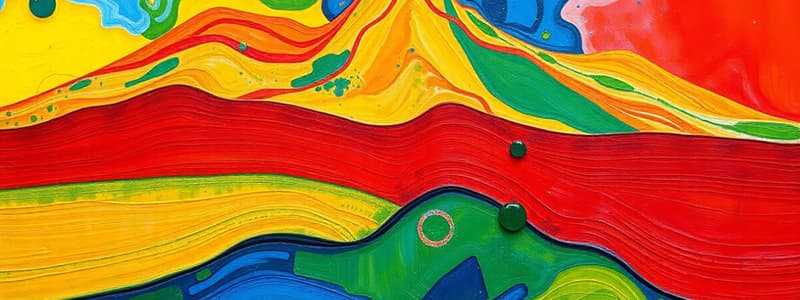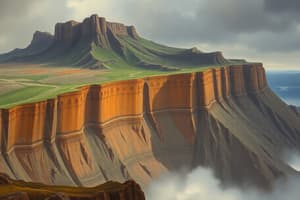Podcast
Questions and Answers
Which of the following is the primary driving force behind plate tectonics?
Which of the following is the primary driving force behind plate tectonics?
- Atmospheric pressure variations
- Gravitational pull from the sun
- Tidal forces from the moon
- Convection currents in the mantle (correct)
Weather describes long-term atmospheric conditions, while climate describes short-term conditions.
Weather describes long-term atmospheric conditions, while climate describes short-term conditions.
False (B)
Name three primary agents of erosion that shape landforms.
Name three primary agents of erosion that shape landforms.
Water, wind, and ice
The continuous circulation of water between the Earth's surface and the atmosphere is known as the ______ cycle.
The continuous circulation of water between the Earth's surface and the atmosphere is known as the ______ cycle.
Match each soil horizon with its description:
Match each soil horizon with its description:
Which of the following factors does NOT directly influence climate?
Which of the following factors does NOT directly influence climate?
A transform plate boundary is where two plates move directly towards each other.
A transform plate boundary is where two plates move directly towards each other.
What is the difference between physical and chemical weathering?
What is the difference between physical and chemical weathering?
Large-scale ecosystems characterized by specific climate and vegetation are called ______.
Large-scale ecosystems characterized by specific climate and vegetation are called ______.
Which soil horizon is most fertile and important for agriculture?
Which soil horizon is most fertile and important for agriculture?
Flashcards
What is Geography?
What is Geography?
The study of the Earth's landscapes, environments, and the relationships between people and their environments.
What is physical geography?
What is physical geography?
Focuses on the natural processes of the Earth, including climate, landforms, vegetation, soils, and water.
What is the Earth's crust?
What is the Earth's crust?
The outermost solid layer of the Earth.
What are Convergent boundaries?
What are Convergent boundaries?
Signup and view all the flashcards
What is climate?
What is climate?
Signup and view all the flashcards
What are landforms?
What are landforms?
Signup and view all the flashcards
What is erosion?
What is erosion?
Signup and view all the flashcards
What is Hydrology?
What is Hydrology?
Signup and view all the flashcards
What are Watersheds?
What are Watersheds?
Signup and view all the flashcards
What is soil?
What is soil?
Signup and view all the flashcards
Study Notes
- Geography examines Earth's landscapes, environments, and human-environment connections.
- Physical geography concerns itself with Earth's natural processes.
- The focus is on patterns pertaining to climate, landforms, vegetation, soils, and water.
- Physical geography studies how these patterns are formed and how they change.
- Understanding the natural world is aided by physical geography.
- Environmental studies and resource management are built upon its foundations.
Earth's Structure and Plate Tectonics
- Earth has layers: crust, mantle, and core.
- The crust, solid and outermost.
- The mantle, mostly solid, lies beneath the crust.
- The core, Earth's center, is mostly iron and nickel, and has a solid inner part and liquid outer part.
- Plate tectonics explains the movement of Earth's lithosphere.
- The lithosphere is split into plates.
- They float on the semi-molten asthenosphere.
- Mantle convection currents drive the plates.
- Plate boundaries: convergent, divergent, and transform.
- Convergent boundaries: plates collide, forming mountains, volcanoes, and subduction zones.
- Divergent boundaries: plates separate, causing seafloor spreading and rift valleys.
- Transform boundaries: plates slide past each other, causing earthquakes.
- Plate tectonics shapes the surface and causes geological events.
Climate and Weather
- Climate: long-term weather patterns of a region.
- Weather: short-term atmospheric conditions at a specific time and place.
- Key elements: temperature, precipitation, wind, and humidity.
- Climate is affected by latitude, altitude, nearness to water, and ocean currents.
- Seasonal changes in solar radiation are due to Earth's tilt.
- Atmospheric circulation distributes heat.
- The Coriolis effect deflects winds due to Earth's spin.
- Ocean currents move heat from the equator toward the poles.
- The greenhouse effect traps heat.
- Greenhouse gases: carbon dioxide, methane, and water vapor.
- Climate change: long-term shifts in temperature and weather.
- These shifts are caused by greenhouse gas increases due to human activity.
Landforms and Processes
- Landforms: natural surface features.
- Examples: mountains, plains, plateaus, and valleys.
- Processes shaping landforms: weathering, erosion, and deposition.
- Weathering breaks down rocks.
- Physical weathering: mechanical disintegration.
- Chemical weathering: alteration of rock composition.
- Erosion: removal and transport of weathered material.
- Primary agents of erosion: water, wind, and ice.
- Deposition: laying down eroded material elsewhere.
- Rivers create valleys, floodplains, and deltas.
- Glaciers carve U-shaped valleys and drop moraines.
- Wind forms dunes and loess deposits in dry areas.
- Coastal landforms are shaped by waves and tides.
- Examples: cliffs, beaches, and barrier islands.
Hydrology and Water Resources
- Hydrology: the study of water's movement, distribution, and quality.
- The hydrologic cycle: continuous water circulation.
- This includes evaporation, transpiration, condensation, precipitation, and runoff.
- Surface water: rivers, lakes, and wetlands.
- Groundwater: underground water in aquifers.
- Watersheds: land areas draining into a common outlet.
- Water is critical for people and ecosystems.
- Water scarcity affects many areas.
- Overuse, pollution, and climate change cause scarcity.
- Water management: strategies for sustainable use.
- Examples: irrigation, dams, and water treatment.
Biogeography and Ecosystems
- Biogeography studies the distribution of species and ecosystems.
- It examines climate, topography, soils, and historical events.
- Ecosystems: communities of living things interacting with their environment.
- Biomes: large ecosystems with specific climate and vegetation.
- Examples: forests, grasslands, deserts, and tundra.
- Biodiversity: the variety of life forms.
- It is key for ecosystem stability and resilience.
- Habitat loss, deforestation, and pollution threaten biodiversity.
- Conservation protects species and ecosystems.
- Examples: national parks, reserves, and habitat restoration.
Soils
- Soil is dynamic, natural, with minerals, organic matter, water, air, and organisms.
- It forms from rock weathering and organic decomposition.
- Soil horizons: distinct layers in a soil profile.
- The O horizon: surface layer, with lots of organic matter.
- The A horizon: topsoil, biologically active.
- The B horizon: subsoil, minerals accumulate there.
- The C horizon: weathered parent material.
- Soil properties: texture, structure, pH, and nutrient content.
- Soil texture: proportion of sand, silt, and clay.
- Soil structure: arrangement of soil particles.
- Soil pH: acidity or alkalinity measurement.
- Soil fertility: ability to support plant growth.
- Soil erosion degrades soil and reduces agricultural productivity.
- Soil conservation: conservation tillage, terracing, and crop rotation.
Natural Hazards
- Natural hazards threaten life and property.
- Examples: earthquakes, volcanoes, floods, droughts, and landslides.
- Earthquakes: sudden energy release in Earth's crust.
- Volcanoes: magma reaching the surface.
- Floods: excessive rain or snowmelt.
- Droughts: long periods of low precipitation.
- Landslides: soil and rock moving downslope.
- Hazard assessment identifies and maps hazards.
- Risk management reduces vulnerability to hazards.
- Examples: early warning systems, evacuation plans, and building codes.
Studying That Suits You
Use AI to generate personalized quizzes and flashcards to suit your learning preferences.



